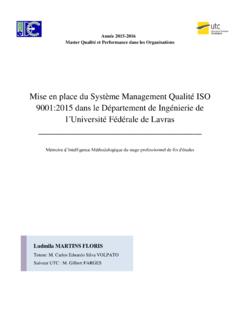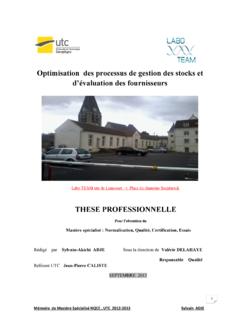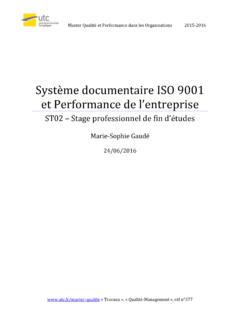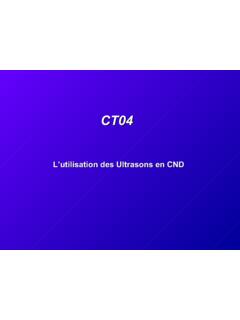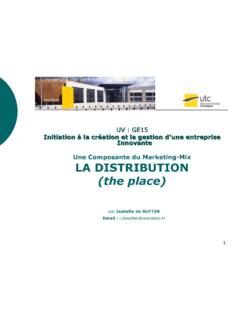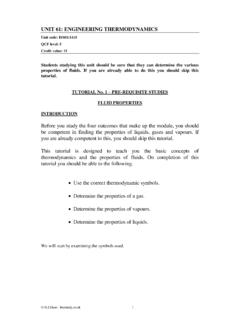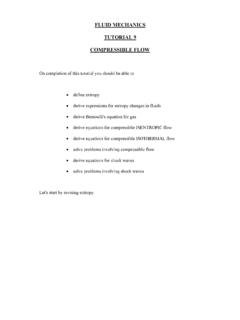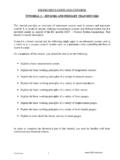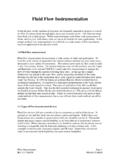Transcription of Tutorial: Dam-Break Simulation Using FLUENT’s …
1 Tutorial: Dam-Break Simulation UsingFLUENT s Volume ofFluid ModelPurposeThis tutorial examines the Dam-Break problem Using the Volume of fluid (VOF) tutorial demonstrates how to do the following: Set up a Dam-Break problem. Choose the time step by estimating the maximum possible velocity of the interfaceand the grid cell dimension. Solve the problem Using the VOF model. Manipulate the solution tutorial assumes that you are familiar with theFLUENT interface and that you havea good understanding of basic setup and solution procedures. In this tutorial, you will useVOF multiphase model, so you should have some experience with it.
2 This tutorial will notcover the mechanics of Using this model; instead, it will focus on the application of thismodel to solve a Dam-Break you have not used this model before, it would be helpful to first refer to s Guide and Tutorial DescriptionThe initial setup of the Dam-Break problem is shown in this problem, a rectangular column of water, in hydrostatic equilibrium, is confinedbetween two walls. Gravity is acting downwards with a magnitude of m/s2. At thebeginning of the calculation, the right wall is removed and the water is allowed to flow outto the horizontal fluent Inc.
3 November 6, 20061 Dam-Break Simulation UsingFLUENT s Volume of fluid ModelContours of Volume fraction (water-liquid) (Time= +00) fluent (2d, pbns, vof, lam, unsteady) + +00 Figure 1: Initial Setup of the the mesh file, the working the 2D(2d)version fluent Inc. November 6, 2006 Dam-Break Simulation UsingFLUENT s Volume of fluid ModelSetup and SolutionStep 1: the grid the the grid (Figure2).Display (a)Click to open theGrid By will assign a different color to each zone in the domain, rather than toeach type of theGrid Colorspanel.(b)ClickDisplay.
4 (c)Close theGrid (2d, pbns, lam) Figure 2: Grid Displayc fluent Inc. November 6, 20063 Dam-Break Simulation UsingFLUENT s Volume of fluid ModelStep 2: the solver Models (a)SelectUnsteadyforTime.(b)ClickOKto close the model Models (a)Select theVolume of Fluidmultiphase model.(b)EnableImplicit Body Force Formulation.(c)ClickOKto close theMultiphase 3: MaterialsThe default properties of water and air are the correct values for this problem. You cancheck them in the material (a)Retain the default settings forair.(b)Define the new material by copyingwater-liquid (h20<l>)from theFluent Database.
5 (c)ClickChange/Createand close the primary (air) and secondary (water-liquid) (a)Specifyairas the primary phase.(b)Specifywater-liquidas the secondary phase.(c)Close fluent Inc. November 6, 2006 Dam-Break Simulation UsingFLUENT s Volume of fluid ModelStep 4: Operating ConditionsDefine Operating Accelerationin Operating Densityand retain the default value forOperating close theOperating 5: Boundary ConditionsDefine Boundary the boundary conditions forpoutlet.(a)In the drop-down list forPhase, selectwater-liquidand click the default value of0forBackflow Volume close thePressure Outletpanel.
6 (b)Close theBoundary 6: the solution Controls (a) , , and1for the remaining parametersin theUnder-Relaxation Factorsgroup box.(b)SelectPRESTO!from thePressuredrop-down list, andFirst Order UpwindfromtheMomentumdrop-down list in theDiscretizationgroup box.(c)SelectPISO from thePressure-Velocity Couplingdrop-down is recommended for transient flow simulations.(d)ClickOKto close theSolution the termination criteria Controls (a) ValueforPressure.(b)ClickOKto close theMultigrid fluent Inc. November 6, 20065 Dam-Break Simulation UsingFLUENT s Volume of fluid the Initialize (a)Retain the default values for all components and clickInit.
7 (b)Close theSolution the initial distribution of the Initialize (a)In the drop-down list forPhase, selectwater-liquid.(b)In theVariablelist, selectVolume Fraction.(c)Selectwaterin theZones To Patchlist.(d)Set theValueto1.(e)ClickPatchand close the plotting of residuals during the Monitors (a)EnablePlot.(b)ClickOKto close theResidual the time step by estimating the maximum possible velocity of the interfaceand the grid cell gh= 2v2fluidvfluid= 2gh 10m/s4t=4xcell/vfluid the time stepping (a) (s) forTime Step Size.(b)Enter20forNumber of Time Steps.(c)Enter40forMax.
8 Iterations per Time Step.(d) the initial case and data files, ( ). start the the specified number of iterations, run the calculation furthersuccessively specifying 30, 30, and 20 (a total of 80) forNumber of Time fluent Inc. November 6, 2006 Dam-Break Simulation UsingFLUENT s Volume of fluid the case and data files after each set of will help in viewing the progress of the VOF 7: PostprocessingThe velocity vectors and contours of velocity for the VOF model are displayed for four timestep values. The following figures (Figure3to Figure9) show the progression of the solutionas the number of time steps is velocity vectors after 20 time steps (Figure3).
9 (a)SelectVelocityfrom theVectors Ofdrop-down list.(b)Selectmixturefrom thePhasedrop-down list.(c) Magnitudefrom theColor Bydrop-down lists filled contours of volume fraction of water-liquid after 20 time steps (Figure4).(a) Fractionfrom theContours Ofdrop-down lists.(b)Selectwater-liquidfrom thePhasedrop-down list and , display the contours of volume fraction and velocity vectors after 50, 80,and 100 time steps (Figure5to Figure10).c fluent Inc. November 6, 20067 Dam-Break Simulation UsingFLUENT s Volume of fluid ModelVelocity Vectors Colored By Velocity Magnitude (mixture) (m/s) (Time= ) fluent (2d, pbns, vof, lam, unsteady) + + + + + + + + + + + + + + + + 3: Velocity Vectors Colored By Velocity Magnitude after 20 Time StepsContours of Volume fraction (water-liquid) (Time= ) fluent (2d, pbns, vof, lam, unsteady) + +00 Figure 4: Contours of Water Volume Fraction after 20 Time Steps8c fluent Inc.
10 November 6, 2006 Dam-Break Simulation UsingFLUENT s Volume of fluid ModelVelocity Vectors Colored By Velocity Magnitude (mixture) (m/s) (Time= ) fluent (2d, pbns, vof, lam, unsteady) + + + + + + + + + + + + + + + + + + 5: Velocity Vectors Colored By Velocity Magnitude after 50 Time StepsContours of Volume fraction (water-liquid) (Time= ) fluent (2d, pbns, vof, lam, unsteady) + +00 Figure 6: Contours of Water Volume Fraction after 50 Time Stepsc fluent Inc. November 6, 20069 Dam-Break Simulation UsingFLUENT s Volume of fluid ModelVelocity Vectors Colored By Velocity Magnitude (mixture) (m/s) (Time= ) fluent (2d, pbns, vof, lam, unsteady) + + + + + + + + + + + + + + + + + + 7: Velocity Vectors Colored By Velocity Magnitude after 80 Time StepsContours of Volume fraction (water-liquid) (Time= ) fluent (2d, pbns, vof, lam, unsteady) + +00 Figure 8: Contours of Water Volume Fraction after 80 Time Steps10c fluent Inc.

